Mycotoxins in dairy cows
T5X and Zootechnical Performances of Dairy Cows Facing Suspected Mycotoxins Problems. Northern Profile (Trichotecens / ZEA / Fumo)
Published: February 2, 2012
By: Erwan Leroux (Neovia)
In 9 farms, with a total of 715 cows, where multi-contamination (trichotecens / zearalenon / fumonisins) was encountered, the addition of 100 grams of T5X SD in the TMR for 2 months, results in:
· + 2 kg of milk / day / DC (p<0.05)
· + 100 grams of protein / day / DC (p<0.05)
· + 5 kg of crude matter intake / day / DC
· -50 000 cells / ml
In the French context, the economic gain is +0.73 € per cow per day! The return on investment index was over 4.
These trials have shown that ruminants, and especially dairy cows, may be sensitive to mycotoxins.
After checked diet balance and parasitism, if breeding problems remain unexplained, mycotoxins contamination should be considered.
T5X concept offers a reliable solution to help breeders overcome this critical period.
· + 2 kg of milk / day / DC (p<0.05)
· + 100 grams of protein / day / DC (p<0.05)
· + 5 kg of crude matter intake / day / DC
· -50 000 cells / ml
In the French context, the economic gain is +0.73 € per cow per day! The return on investment index was over 4.
These trials have shown that ruminants, and especially dairy cows, may be sensitive to mycotoxins.
After checked diet balance and parasitism, if breeding problems remain unexplained, mycotoxins contamination should be considered.
T5X concept offers a reliable solution to help breeders overcome this critical period.
MATERIAL & METHODS:
Selected herds characteristics: 9 French dairy herds (in total: 715 cows in lactation) with:
- Breeding problems non explained by zootechnical performances and/or the sanitary state of the animals (recurrent mastitis, high level of somatic cells in the milk , ingestion and/or milk production under expectation),
- Problems not due to an unbalanced ration, or to an infectious disease,
- No grazing period, in order to keep the ration as stable as possible.
- Problems not due to an unbalanced ration, or to an infectious disease,
- No grazing period, in order to keep the ration as stable as possible.
Mycotoxins contamination:
Analysis of the TMR: the samples were taken at the exit of the mixer or in the feeding trough, to ensure a good representation of the real contamination ingested by animals.
43 different mycotoxins and metabolites were analysed by Gas Chromatography coupled with Mass Detection. In each TMR sample analysed, between 3 and 8 different mycotoxins were found, with variable levels (cf. table). These mycotoxins were all "field mycotoxins".
7 TMR coming from the 9 herds, levels of mycotoxins are considered risky for animals.
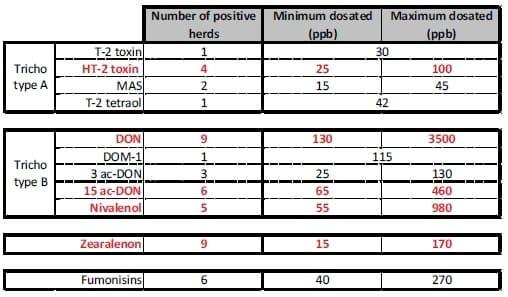

Experimental diagram:
The data from 2 months before T5X SD supplementation was compared to the 2 following months with T5X SD in the feed.

Animal feed: No feed formulation variation during the whole trial period (control period + experimental period). If any, the biased period was not taken into account for the statistical analysis.
Dosage of T5X SD: 100 grams / day / cow, mixed into the mixer or top-fed into the feeding trough (dosage recommended for dairy cows when mycotoxins problems occur).
Statistical analysis: In order to compare each cow and each herd to the others, all data were statistically corrected by several factors (lactation rank, lactation stage, original herd). The protein content was also corrected by the seasonal factor.
RESULTS (synthesis of 9 herds):
Milk production:
Milk production (fig. 2) was very stable during both periods (control and experimental). After the beginning of T5X SD supplementation, milk production increased significantly (p=0.015*) by about 2 kg of milk/cow/day, and stayed stable at this higher level during the second month of the trial.
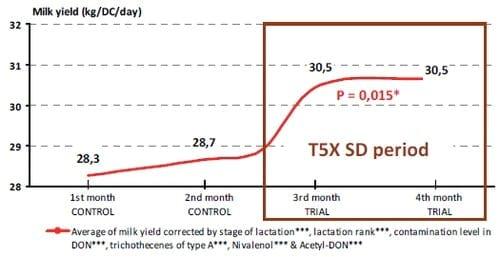
Figure 2: Evolution of milk production (kg/DC/day) during the trial period.
Protein content and Milk protein yield:
Control period: the protein content decreased slightly (fig. 3). This is linked to a moderate increase of milk production, which diluted the protein content into the milk.
Experimental period: in contrast, T5X SD increased milk production, with a higher protein content of more than 0.6 gram/kg. It induces a significant increase of the milk protein yield by 10% (p=0.014*) (= + 100 grams of protein / day / DC (p<0.05)
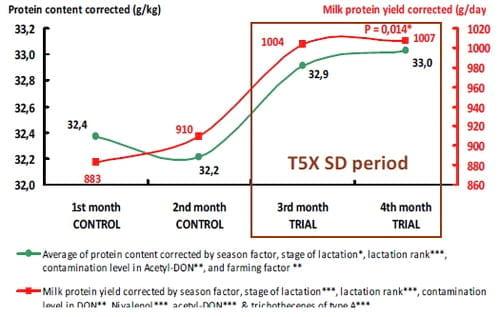
Figure 3: Evolution of the protein rate and the milk protein yield.
Feed consumption:
The increase of both, milk production and protein yield, results of a better assimilation of the diet energy. It may be explained by 2 hypotheses:the addition of T5X SD either increases the consumption rate, or gives a better valorisation of the TMR.
On regular weekly basis, only 1 herd weighed out the TMR distributed and the feed refusals (fig 4). Thus, after 3 week-trials, cows consumed about +5 kg crude matter per day, which is about +2 kg of dry matter
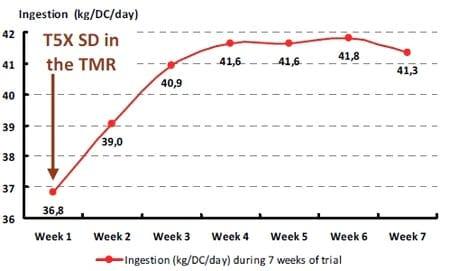
Figure 4: Evolution of the feed consumption (one of the 9 herds in this trial).
Somatic cells rate in milk:
During the control period, somatic cell counts were variable, but stayed at a high level (> 300 000 cells/ml). Thanks to T5X SD, an average decrease of 50 000 cells/ml was observed (cf. Fig 5 - Values on average for each herd (no individual data) extracted from tank quality control tests - 3 times/month. Cows with clinical mastitis and under medical treatment were not taken into account.). Among 6 herds with abnormal cell count before T5X SD supplements (> 350 000 for several months), 5 showed a reduction of cell count by about 100 000 cells/ml.
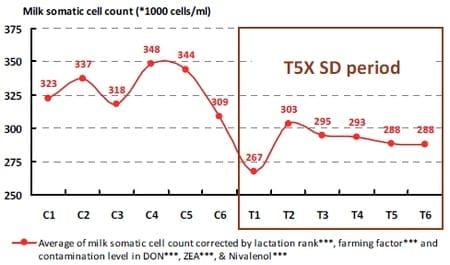
Figure 5: Evolution of the somatic cell count of the milk (*1000 cells/ml) during the trial.
Related topics
Authors:
Join to be able to comment.
Once you join Engormix, you will be able to participate in all content and forums.
* Required information
Would you like to discuss another topic? Create a new post to engage with experts in the community.
Create a postNeovia
25 de marzo de 2013
Daer Mr Zakraoui,
These results are available in all cases of feeding. When speaking on mycotoxins contaminations, whatever the kind of TMR, the most important is to know the global contamination, that's why for ruminants, it is important to analyze the TMR when you are looking for the mycotoxins and not the raw materials one by one.
Best regards,
Erwan LEROUX
NEOVIA product manager
22 de marzo de 2013
I want to ask if these reasults are availble in all cases of feeding, there is no information about the composition of the tmr in this experiment:
28 de febrero de 2012
Dear Author,
I would be glad if you could give a good idea further to investigate the "Mycotoxin" availabality in milk and how to reduce such toxic material in dairy cattle and milk production to save public health.






.jpg&w=3840&q=75)